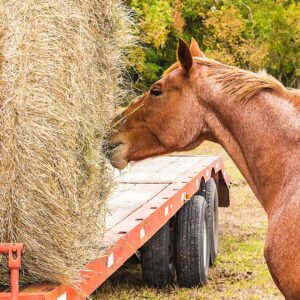 Long-Stem vs. Short-Stem Forages: Nutritionists recommend horses consume at least one to two pounds (0.5 to 1 kilograms) of long-stem forage each day. Long-stem forage is best defined as hay or pasture. This recommendation respects the natural desire of horses to graze. After all, they are hardwired to spend more than half of their day eating. Forage products that include extremely short pieces of fiber such as cubes, pellets, or chaff are often fed in lieu of long-stem forage. A spate of inquiries regarding the necessity of long-stem forage has landed in the electronic mailboxes of Kentucky Equine Research nutritionists. The overwhelming inquiry:
Long-Stem vs. Short-Stem Forages: Nutritionists recommend horses consume at least one to two pounds (0.5 to 1 kilograms) of long-stem forage each day. Long-stem forage is best defined as hay or pasture. This recommendation respects the natural desire of horses to graze. After all, they are hardwired to spend more than half of their day eating. Forage products that include extremely short pieces of fiber such as cubes, pellets, or chaff are often fed in lieu of long-stem forage. A spate of inquiries regarding the necessity of long-stem forage has landed in the electronic mailboxes of Kentucky Equine Research nutritionists. The overwhelming inquiry:
Can short-stem forage products completely satisfy a horse’s forage requirement?
According to Kathleen Crandell, Ph.D., a KER nutritionist, the answer is yes, but there is a caveat. “If a horse does not have enough forage to chew on to fill the time, it might develop abnormal behaviors. For example, cribbing, weaving, manure- eating, and mane and tail chewing. Many horses without access to long-stem forage seek chewing satisfaction through destruction of wooden surfaces within reach,” said Crandell.
Hay pellets and cubes are typically made from good-quality forage. They can therefore help satisfy a horse’s nutritional requirements. This is especially true if alfalfa products are used for horses with elevated nutrient needs such as youngsters or those exercised frequently.
Forage Requirements:
On the flip side, the quality of chaff or chopped forage is less reliable. High-quality chaff originates from hay, not straw. Though chaff made from straw is popular in some regions of the world, straw offers few nutrients to horses, and it is high in indigestible fiber, which increases the risk of impaction colic. Therefore, straw chaff should be fed in small amounts, primarily as a way to slow consumption of a grain meal, and should not be used as the sole forage. Chaffs made from high-quality hay, however, can be the principal forage source.
In sum, horses can survive without long-stem forage in their diets. That is, provided the forage requirement is met (at least 1-1.5% of body weight per day) through alternative forages. To maximize “chew time,” though, it is best to give horses some long-stem forage daily.
Resources:
In conclusion, do you have questions about Long-Stem vs. Short-Stem Forages? Contact us at J & J Hay Farms by clicking here!
Article Sources: Kentucky Equine Research
